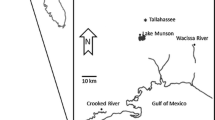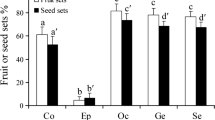Abstract
Bulbils are small aerial rosettes that occur on the flowering stalks of semelparous Agave plants and in related families, and that are capable of acting as clones of the parent plant. We hypothesized that bulbil formation was inversely related to fruiting success in the flowering stalk, and we explored this hypothesis in A. macroacantha, a species from South-Central Mexico. Forty randomly chosen plants were divided amongst three treatments: (a) elimination of all floral buds, (b) exclusion of pollinators, and (c) control. We also studied 22 plants in which the flowering stalk had been felled by goat grazing. Between September and November 1991 we kept a record of the numbers of bulbils and capsules produced in each flowering stalk. Significant (P<0.0001) differences between treatments were found in the proportion of plants hearing capsules and bearing bulbils. The control treatment had the highest proportion of plants producing capsules, treatment a had the highest proportion of individuals bearing bulbils, while treatment b showed an intermediate response. In the goat-grazed group, 45% of the plants failed to produce any propagative structure after the stalk was cut, and half of all plants produced bulbils on the remaining stump. A significant inverse relationship between the numbers of capsules and the numbers of bulbils per plant was found for the three randomly assigned treatments. Our results suggest that once the production of the flowering stalk has been triggered and the death of the rosette is irreversible, bulbils may act as an insurance mechanism that increases the probability of successful reproduction of the genet.
Similar content being viewed by others
References
Abrahamson WG (1980) Demography and vegetative reproduction. In: Solbrig O (ed) Demography and evolution in plant populations (Botanical monographs Vol15). Blackwell, Oxford, pp 89–106
Alvarez A (1986) Inflorescencias de Agaváceas. Rev Jardín Bot Nac Habana 7(2):2–14
Arita HT (1991) Spatial segregation in long-nosed bats. Leptonycteris nivalis and Leptonycteris curasoae in Mexico. J Mammal 72:706–714
Arita HT, Humphrey SR (1988) Revisión taxonómica de los murciélagos magueyeros del género Leptonycteris (Chiroptera: Phyllostomidae). Acta Zool Mex NS 29:1–60
Barrientos F, Villegas A, Vázquez A (1985) Métodos de propagación de Agaves. In: Cruz C, Castillo L del, Robert M, Ondarza RN (eds) Simposio sobre biología, y aproyechamiento integral del henequén y otros Agaves. CICY, Mexico, pp 91–96
Bazzaz FA, Ackerly DD (1992) Reproductive allocation and reproductive effort in plants. In: Fenner M (ed) Seed. The ecology of regeneration in plant communities. CAB International, Wallingford, pp 1–22
Bell AD (1991) Plant form. An illustrated guide to flowering plant morphology. Oxford University Press, Singapore
Bibiloni G, Llorens L, Rita J (1987) The genus Brimeura Salisb in the Balearic Islands (Spain). Acta Bot Malacitana 12:151–160
Cave MS (1964) Cytological observations on some genera of the Agavaceae. Madroño 17:163–170
Crawley MJ (1983) Herbivory: the dynamics of animal-plant interactions. Blackwell, Oxford
Draper N, Smith H (1981) Applied regression analysis, 2nd edn. Wiley, New York
Eguiarte L, Búrquez A (1987) Reproductive ecology of Manfreda brachystachya, an iteroparous Agavaceae. Southwest Nat 32: 169–178
Faegri K, Pijl L van der (1971) The principles of pollination ecology. Pergamon, Toronto
Fenner M (1985) Seed ecology. Chapman and Hall, New York
García E (1981) Modificaciones al sistema de clasificación climática de Köppen, Instituto de Geografía-UNAM, México
Gentry HS (1982) Agaves of continental North America. The University of Arizona Press, Tucson, Arizona
Gentry HS (1985) On the taxonomy of the genus Agave. In: Cruz C, Castillo L del, Robert M, Ondarza RN (eds) Simposio sobre biología y aprovechamiento integral del henequén y otros Agaves. CICY, Mexico, pp 29–38
Gómez-Pompa A (1963) El género Agave. Cact Suculentas Mex 8:3–25
Greig-Smith P (1983) Quantitative plant ecology, 3rd edn. Blackwell, Oxford
Hanks GR (1987) Effects of growth retardants on the bulbil production by Narcissus twin-scales. Ann Appl Biol 110:203–208
Hart RH, Norton BE (1988) Grazing management and vegetation response. In: Tueller RT (ed) Vegetation science applications for rangeland analysis and management. Kluwer Academic, Dordrecht, pp 493–526
Hodgson WC, Nabhan GP, Ecker L (1989) Conserving rediscovered Agave cultivars. Agave 3:9–11
Howell DJ (1979) Flock foraging in nectar-feeding bats. Am Nat 114:23–49
Howell DJ, Roth BS (1981) Sexual reproduction in Agave: the bencfits of bats; the cost of semelparous advertising. Ecology 62:1–7
Lock G (1985) On the scientific and practical aspect of sisal (Agave sisalana) cultivation. In: Cruz C, Castillo L del, Robert M, Ondarza RN (eds) Simposio sobre biología y aprovechamiento integral del henequén y otros Agaves. CICY, Mexico, pp 99–119
Mabberley DJ (1987) The plant-book. A portable dictionary of the higher plants. Cambridge University Press, Cambridge
McCullagh P, Nelder JA (1983) Generalized linear models. Chapman and Hall, London
Meyrán GJ (1980) Guía botánica de cactáceas y otras suculentas del Valle de Tehuacán. Sociedad Mexicana de Cactología, Mexico
MNCP (1988) El maguey; árbol de las maravillas. Museo Nacional de Culturas Populares, Mexico
Nobel PS (1977) Water relations of flowering of Agave deserti. Bot Gaz 138:1–6
Nobel PS (1988) Environmental biology of Agaves and cacti. Cambridge University Press, New York
Passam HC, Wickham LD, Wilson LA (1982) Comparative observation on the polarity of sprouting of bulbils of Dioscorea bulbifera and D. alata. Ann Bot 50:359–366
Pijl L van der (1972) Principles of dispersal in higher plants. Springer, Berlin Heidelberg New York
Powers DE, Backhaus RA (1989) In vitro propagation of Agave arizonica Gentry and Weber. Plant Cell Tissue Organ Cult 16: 57–60
Robert M, García A (1985) El cultivo de tejidos vegetales y su posible aplicación en el mejoramiento genético de las Agaváceas. In: Cruz C, Castillo L del, Robert M, Ondarza RN (eds) Simposio sobre biología y aprovechamiento integral del henequén y otros Agaves. CICY, Mexico, pp 83–89
Rzedowsky J (1978) Vegetación de México. Limusa, Mexico
Sarukhán J (1976) On selective pressures and energy allocation in populations of Ranunculus repens L., R. bulbosus L., and R. acris L. Ann Mo Bot Gard 63:290–308
Smith EC (1965) Flora, Tehuacan Valley. Fieldiana Bot 31:107–143
Sokal RR, Rohlf FJ (1981) Biometry, 2nd edn. Freeman, San Francisco
Solbrig O (1976) On the relative advantages of cross-and self-fertilization. Ann Mo Bot Gard 63:262–276
Stearns SC (1992) The evolution of life histories. Oxford University Press, New York
Tucker T, Leininger WC (1990) Differences in riparian vegetation structure between grazed areas and exclosures. J Range Manage 43:295–299
Widén B, Widén M (1990) Pollen limitation and distance-dependent fecundity in females of a clonal gymnodioecious herb Glechoma hederaceae (Lamiaceae). Oecologia 83:191–196
Widén M (1992) Sexual reproduction in a clonal gymnodioecious herb Glechoma hederaceae. Oikos 63:430–438
Willson MF, Price PW (1977) The evolution of inflorescence size in Asclepias (Asclepiadaceae). Evolution 31:495–511
Zavala-Hurtado JA (1982) Estudios ecológicos en el Valle semiárido de Zapotitlán, PueblA. I. Clasificación numérica de la vegetación basado en atributos binarios de presencia o ausencia de las especies. Biótica 7:99–120
Author information
Authors and Affiliations
Rights and permissions
About this article
Cite this article
Arizaga, S., Ezcurra, E. Insurance against reproductive failure in a semelparous plant: bulbil formation in Agave macroacantha flowering stalks. Oecologia 101, 329–334 (1995). https://doi.org/10.1007/BF00328819
Received:
Accepted:
Issue Date:
DOI: https://doi.org/10.1007/BF00328819




